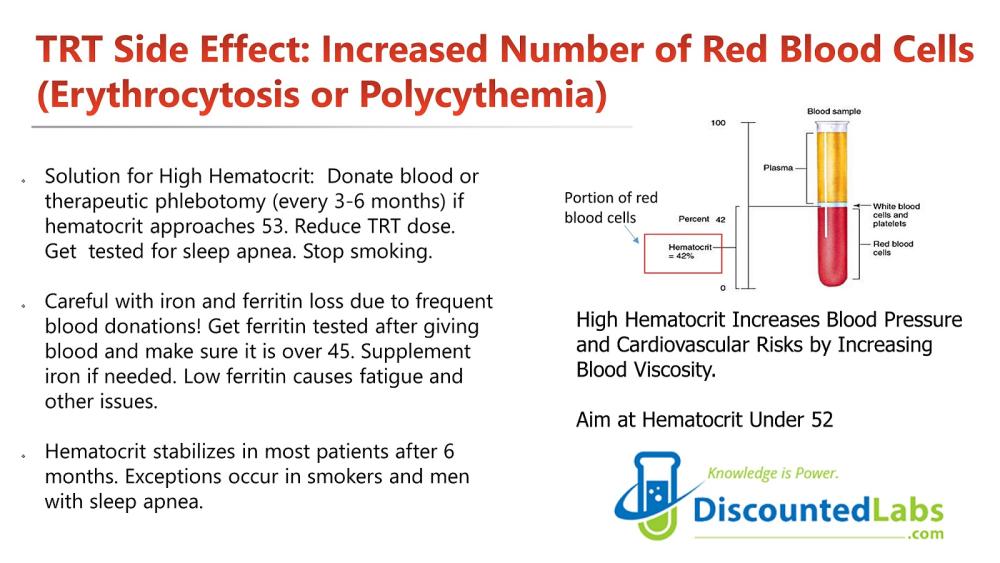Nelson Vergel
Founder, ExcelMale.com
Understanding Therapeutic Phlebotomies to Lower High Hematocrit
What is High Hematocrit?
High hematocrit occurs when your body produces an increased number of blood cells, leading to thicker, more "viscous" blood. This condition strains the heart's ability to pump blood effectively, increasing the risk of blood pressure issues, strokes, and heart attacks.
Testosterone Therapy and Hematocrit Levels
Testosterone replacement therapy, often used to boost muscle mass and sex drive, can increase blood cell production. This is beneficial for those with anemia but risky in terms of hematocrit levels, especially with intramuscular testosterone, which may increase hematocrit more than other methods like patches. Factors like smoking can exacerbate the condition, leading to high hematocrit, also called polycythemia or high red blood cell count (RBC).
Preventing and Managing Polycythemia
Importance of Monitoring
Monitoring hemoglobin and hematocrit levels is essential during testosterone therapy. Hemoglobin carries oxygen, while hematocrit indicates blood cell volume percentage. Concern arises if hematocrit levels exceed 52 percent.
Adjusting Therapy
Adjusting testosterone dosage or delivery form may help manage hematocrit levels. However, these changes may not always be sufficient.
Therapeutic Phlebotomy: A Solution
Therapeutic phlebotomy, also known as bloodletting, is a medical procedure that involves the controlled removal of blood to reduce red blood cell levels.
Therapeutic phlebotomy, akin to blood donation, can lower hematocrit levels by approximately 3 percent per pint of blood withdrawn. It's important to balance the frequency and volume of blood extraction to avoid iron and ferritin depletion, which can lead to fatigue.
After the procedure, you should:
- Stay for at least 15 minutes
- Eat and drink something
- Drink more fluids than usual over the next 4 hours
- Raise your arm and apply pressure to the area if there is bleeding from the site of the blood draw
Drink plenty of fluids to replace the fluid that will be removed
Eat a substantial snack 1 hour before you come (for example, a muffin or a sandwich)
Recommended Reading:
High Hematocrit Caused by TRT: How to Lower It?
Guidelines for Monitoring and Donations
Regular blood count tests, including hematocrit and ferritin levels, are recommended post-donation. Typically, a phlebotomy session every 2-3 months is sufficient, with caution, to prevent iron and ferritin depletion.

If you donate blood frequently due to high hematocrit, you can buy a blood donation panel that includes lab tests that can inform you if you are ready for the next phlebotomy. These tests are: hematocrit, iron and total iron binding capacity (TIBC), and ferritin.This panel is designed to determine if: 1. Your blood donation or therapeutic phlebotomy was effective in lowering your high hematocrit without negatively affecting ferritin or iron. 2: It is safe to do another blood donation or therapeutic phlebotomy, depending on ferritin or iron levels.
Cautionary Measures for Maintaining Health
Risks of Excessive Donation
Excessive blood donation can decrease iron and ferritin levels, leading to fatigue. It's usually advised to start donating blood when hematocrit levels are around 51–52 percent.
Complementary Health Practices
While baby aspirin and omega-3 fatty acids might reduce blood viscosity and related heart risks, they should not replace phlebotomy in managing polycythemia.
Where to Get a Therapeutic Phlebotomy in the United States?
Important note: Most of these blood centers require an order from a physician if your hematocrit is too high for a regular blood donation. The Red Cross has a list of exclusions to determine who can donate blood.
National Organization
- American Red Cross: Website
- America's Blood Centers: Website
- Blood Centers of America: Website
- Blood Emergency Readiness Corps: Article
Alaska
- Blood Bank of Alaska: Website
Arkansas
- Arkansas Blood Institute: Website
California
- Central California Blood Center: Website
- LifeStream Blood Bank: Website
- Northern California Community Blood Bank: Website
- San Diego Blood Bank: Website
- Stanford Blood Center: Website
- UCLA Blood & Platelet Center: Website
Delaware
- Blood Bank of Delmarva: Website
Florida
- OneBlood: Website
- SunCoast Blood Centers: Website
- Winter Haven Hospital Community Blood Center: Website
Georgia
Hawaii
- Blood Bank of Hawaii: Website
Illinois
- Versiti Blood Center of Illinois: Website
- Rock River Valley Blood Center: Website
- South Bend Medical Foundation: Website
Indiana
- Versiti Blood Center of Indiana: Website
Iowa
- LifeServe Blood Center: Website
Kentucky
Louisiana
Michigan
- Versiti Blood Center of Michigan: Website
Mississippi
- Mississippi Blood Services: Website
Missouri
- Community Blood Center of Greater Kansas City: Website
Nebraska
- Nebraska Community Blood Bank: Website
New York
- New York Blood Center: Website
Ohio
Oklahoma
- Oklahoma Blood Institute: Website
Pennsylvania
Rhode Island
- Rhode Island Blood Center: Website
South Carolina
- The Blood Connection: Website
Tennessee
Texas
- Carter BloodCare: Website
- We Are Blood: Website
- South Texas Blood: Website
- Texas Blood Institute: Website
Utah
- ARUP Blood Services: Website
Virginia
- Inova Blood Donor Services: Website
Washington
- Bloodworks Northwest: Website
Wisconsin
- Versiti Blood Center of Wisconsin: Website
Multiple States or Regions
- ImpactLife: Website (Serving Illinois, Iowa, Missouri, and Wisconsin)
- LifeSouth Community Blood Centers: Website (Serving multiple states)
- Alliance for Community Transfusion Services: Website
- Lifeline Blood Services: Website
- MEDIC Regional Blood Center: Website
Conclusion
In conclusion, understanding and managing high hematocrit levels are crucial for individuals undergoing testosterone therapy. Regular monitoring, therapeutic phlebotomy, and careful therapy management reduce risks and contribute to a safer treatment experience. Always consult a healthcare provider for personalized advice.
Continue reading...
















